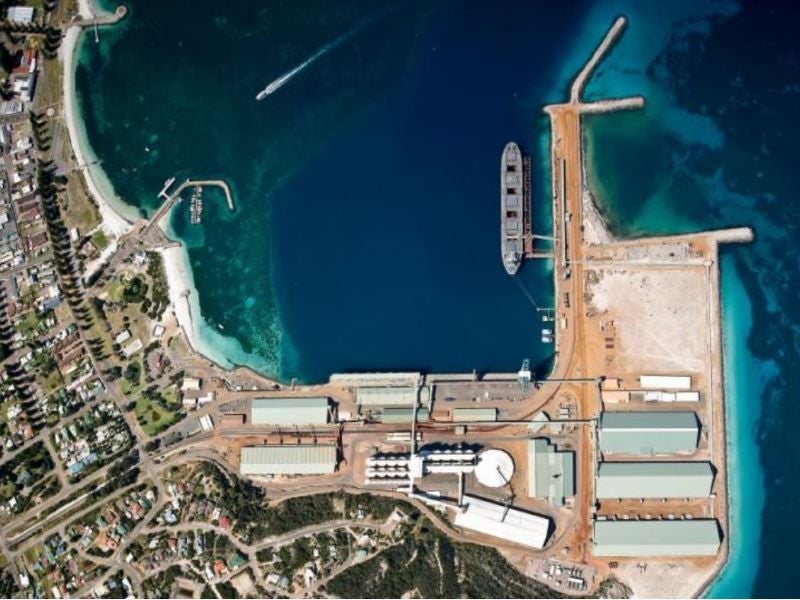Lake Giles is an open-pit iron ore mining project proposed to be developed by Macarthur Minerals in Western Australia (WA).
A feasibility study for the project was announced in March 2022. It indicated a 25-year mine life with an estimated initial capital cost of $568.8m. An additional $43.8m capital cost is estimated to be required for pre-strip operations.
The study focused on the Moonshine and Moonshine North deposits. The other prospects within the project area include the Snark, Sandalwood, Clark Hill North, and Clark Hill South deposits.
Lake Giles project location and geology
The Lake Giles iron project is located 175km north-west of the historic gold mining town, Kalgoorlie-Boulder, and 450km east-northeast of Perth, WA.
The project tenements cover a portion of the north-northwest trending Yerilgee Greenstone Belt, within the Southern Cross Province of the Yilgarn Craton.
Variably foliated gneissic granitoids surround multiple lenticular greenstone belts of the Yilgarn Craton. The greenstone belts comprise metamorphosed ultramafic and mafic volcanic rocks, along with sediments. They host Archean banded iron formations (BIFs) with mafic, intermediate and granitic rock intrusions.
Lake Giles mineralisation and reserves
The primary magnetite mineralisation at the Lake Giles iron project is associated with unoxidised BIF and ultramafic rocks. The secondary iron ore mineralisation at the deposit includes pisolite formations, and goethite-hematite mineralisation associated with oxidised BIF.
The combined proven and probable mineral reserves at the Moonshine and Moonshine North deposits were estimated at 236.6 million tonnes (Mt), grading 28.2% iron, 50.1% silicon dioxide, 1.4% aluminium dioxide and 0.05% phosphorus, as of March 2022.
Mining at Lake Giles iron project
The project proposes to utilise conventional open-pit mining methods for developing the Moonshine and Moonshine North deposits. The operation will be carried out using hydraulic excavators supported by rear dump trucks.
The Moonshine pit will have a length of 3.7km, a width of 700m, and a depth of 250m. The final pit design features two pits with seven internal stages. The Moonshine North pit will measure 1.45km-long, 500m-wide, and 225m-deep.
Approximately 85% of the magnetite ore is hosted in the Moonshine deposit, with a strip ratio of 2.4:1, compared to the 3.8:1 strip ratio for the smaller Moonshine North pit.
The mining fleet will include three primary 350t excavators, five dozers, 18 units of 180t dump trucks, two graders, two water carts, five drills, a wheel dozer, and a small excavator for ancillary work. Two large front-end loaders, two trucks for rehandling, and a reverse circulation (RC) rig will also be used.
Iron ore processing of Lake Giles
Lake Giles is estimated to require ten million tonnes per annum (Mtpa) of ore feed to achieve the target concentrate production of 3Mtpa (dry basis). The run-of-mine (ROM) ore will undergo two stages of conventional crushing in a gyratory crusher and a cone crusher to feed a high-pressure grinding rolls (HPGR) unit.
The fine ore grinding section will consist of two parallel streams, each comprising two stages of mills. It will incorporate a low-intensity magnetic separation (LIMS) unit at the end of each milling stage.
The mill feed will then undergo flotation in a reverse flotation unit to reduce silica in the final concentrate. The concentrate will be sent to a final LIMS stage before undergoing pressure filtration to reduce moisture. The final magnetite concentrate product will then be stockpiled for export.
Infrastructure details
An integrated power generation and battery storage system is proposed to be installed on a build, own, and operate (BOO) basis to meet the 40MW power requirements of the project.
The onsite power infrastructure will include 48MW of natural gas reciprocating engines and a 40MW battery energy storage system (BESS). The plan also includes the installation of 60MW of solar panels.
The project is estimated to require four gigalitres of water a year, which is proposed to be drawn from an onsite bore field.
A 720-room accommodation camp is proposed to be built to facilitate the construction and operations of the mine.
An airport is also proposed to be constructed approximately 2km south of the accommodation camp to reduce the commute times between the project site and the Kalgoorlie-Boulder Airport, the nearest public airport.
A dedicated rail loop and product loading facility are planned to be constructed south of the project site. The 4.6km-long rail loop will handle the transfer of the product from road to rail transport with the help of two front-end loaders. The product will then be transported to the Port of Esperance for export.
Contractors involved
Two Australian drilling contractors, namely iDrilling and Drillwest, were engaged to undertake drilling works at the Moonshine and Moonshine North deposits.
VECKTA, a joint venture (JV) between global professional services consultancy Worley and microgrid planning and assessment software developer XENDEE, was engaged to provide design inputs for a sustainable on-site power solution for the project.
Optimize Group was appointed to provide study management services for the feasibility study.
Projectus Infrastructure was contracted to provide transport infrastructure optimisation advisory services as part of the feasibility study.
FTI Consulting (FTI), a global business advisory firm, was appointed to provide economic and financial modelling services for the project.
Orelogy Mining Consultants and Pells Sullivan Meynink (PSM) were engaged in the mine design and road haulage aspects of the feasibility study.
Stantec, a global consultancy, was contracted to serve as the lead consultant for the project. The contractual scope included performing metallurgical test works, the development of the process flow sheet and engineering design works related to key non-process infrastructure.






